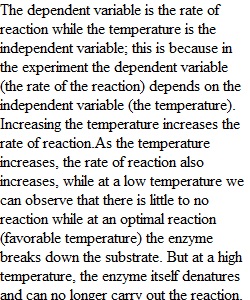


Q WEEK 2 EXPERIMENT ANSWER SHEET Please submit to the Week 2 Experiment dropbox no later than Sunday midnight. SUMMARY OF ACTIVITIES FOR WEEK 2 EXPERIMENT ASSIGNMENT • Experiment 2 Exercise 1a – Effect of temperature on enzyme function • Experiment 2 Exercise 1b – Effect of pH on enzyme function • Experiment 2 Exercise 2 – Cellular Respiration and Photosynthesis Experiment 2 Exercise 1A: Effect of temperature on enzyme function Review the Week 2 Experiment Introductions, our online lecture on Energetics and pp 80 - 82 in your book. For this exercise, we are going to look at the effect of temperature on enzyme function, while holding enzyme concentration and pH constant. Open the following website to get started: Bioman. No date. Enzymatic https://biomanbio.com/HTML5GamesandLabs/LifeChemgames/enzymatichtml5page.html Procedure A. Click on “Start a New Game” and follow the on-screen instructions. B. When you get to the “Main Menu”, click on “Experiments”. You will have to click twice. C. Click “OK” and follow the on-screen instructions. Please note that you do not need to submit the answers from the quiz. Questions 1. In this Experiment, which variable is the dependent variable and which is the independent variable (2 pts)? 2. Describe the relationship between temperature and enzyme activity (1 pts). 3. What is the temperature and enzyme activity was the highest (1 pts)? 4. What happens when the temperature becomes too high? Cited your sources. (2pts) 5. What happens when the temperature become too low? Cited your sources. (2pts) Experiment 2 Exercise 1b: Effect of pH on enzyme function Be sure to review the Week 2 Experiment Introduction, our online lecture on Energetics and pp 80 - 82 in your book. For this experiment, we are going to look at the effect of pH on enzyme function, while holding enzyme concentration, substrate concentration and temperature constant. Go to: Procedure A. Continue from the previous experiment by clicking “OK”. Follow the on-screen instructions. Questions 1. In this Experiment, which variable is the dependent variable, and which is the independent variable (2 pts)? 2. Describe the relationship between pH and enzyme activity. At what pH did you see optimum enzyme activity (2 pts)? 3. Explain your results based on what you have learned about enzymes this week and the factors that affect their function. Cite your source (4 pts). Experiment 2 Exercise 2: Cellular Respiration and Photosynthesis In this exercise, you will test the following hypothesis by predicting results based upon the experimental set-up. a. Hypothesis - Aquatic animals require the presence of plants to provide them with oxygen (via photosynthesis) needed for cellular respiration. The relationship mentioned in the hypothesis is illustrated in the diagram below: In our experiment, we are using an aquatic environment, but the concepts are the same. The snails and Elodea will produce carbon dioxide via cellular respiration. The Elodea will use this carbon dioxide in photosynthesis to produce sugars. The oxygen required for cellular respiration will be generated by the Elodea via photosynthesis. One rack of tubes (1D-4D) will be placed in the dark box for 24 hrs, while the other rack (1L-4L) will be exposed to light. Indicator is added to detect the presence of carbon dioxide. • Blue - no carbon dioxide • Green - medium level of carbon dioxide • Yellow - high level of carbon dioxide Table 3. Predicted Results (6 pts). Test Tube Contents Starting Color Predicted End Color Explain 1D 0 snails, 0 Elodea Green 2D 1 snails, 0 Elodea Green 3D 0 snails, 1 Elodea Green 4D 1 snails, 1 Elodea, Green 1L 0 snails, 0 Elodea, Green 2L 1 snails, 0 Elodea, Green 3L 0 snails, 1 Elodea Green 4L 1 snails, 1 Elodea Green Questions 1. In which treatment(s) did you see the greatest amount of carbon dioxide present? Explain why this was true for each treatment that had the greatest amount; be specific (3 pts). 2. In which treatment(s) did you see the least amount of carbon dioxide present? Explain why this was true for each treatment that had the least and explain what happened to the carbon dioxide that had been present (2 pts). 3. Was there any difference in your results between tubes 3D and 3L? If so, describe what the difference was and why (2 pts). 4. Based on your results, how do you know that snails produce carbon dioxide (2 pts)? 5. What was the purpose of tubes 1D and 1L (2 pts)? ________________________________________ Week 2 Experiment Grading Rubric Component Expectation Points Experiment 2 Exercise 1A Demonstrates an understanding of the relationship between temperature and enzyme function and the ability to conduct an experiment and interpret results (Questions 1-5). 8 pts Experiment 2 Exercise 1B Demonstrates an understanding of the relationship between pH and enzyme function and the ability to conduct an experiment and graph and interpret results (Questions 1-3). 8 pts Experiment 2 Exercise 2 Follows instructions, correctly sets up experiment and records data (Tables 3). 6 pts Experiment 2 Exercise 2 Demonstrates an understanding of the relationship between cellular respiration and photosynthesis and interpretation of experimental results (Questions 1-5) 11 pts TOTAL 33 pts
View Related Questions